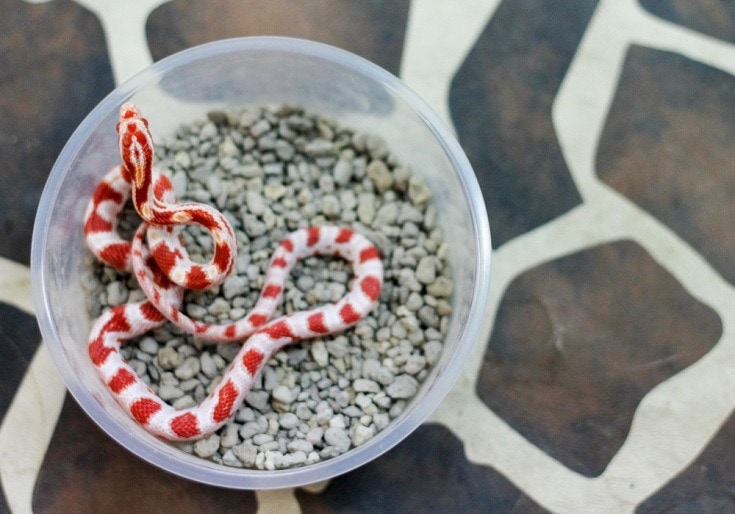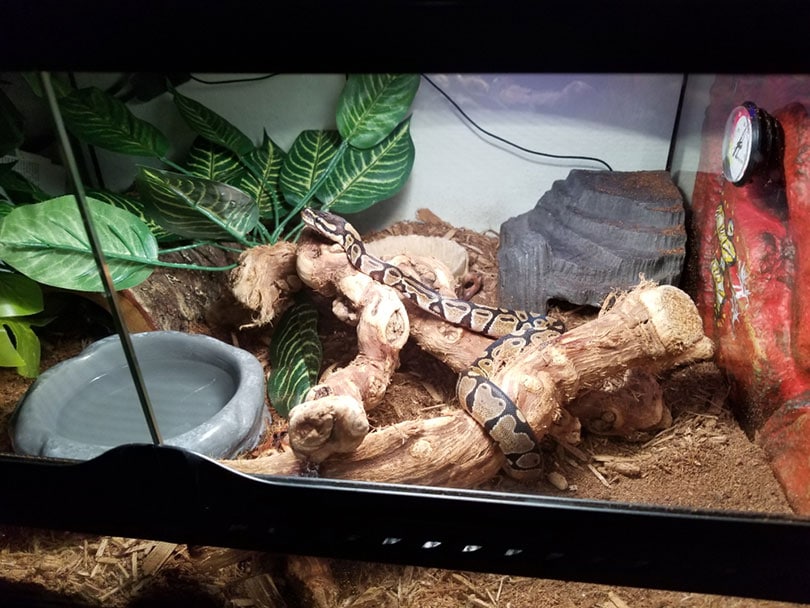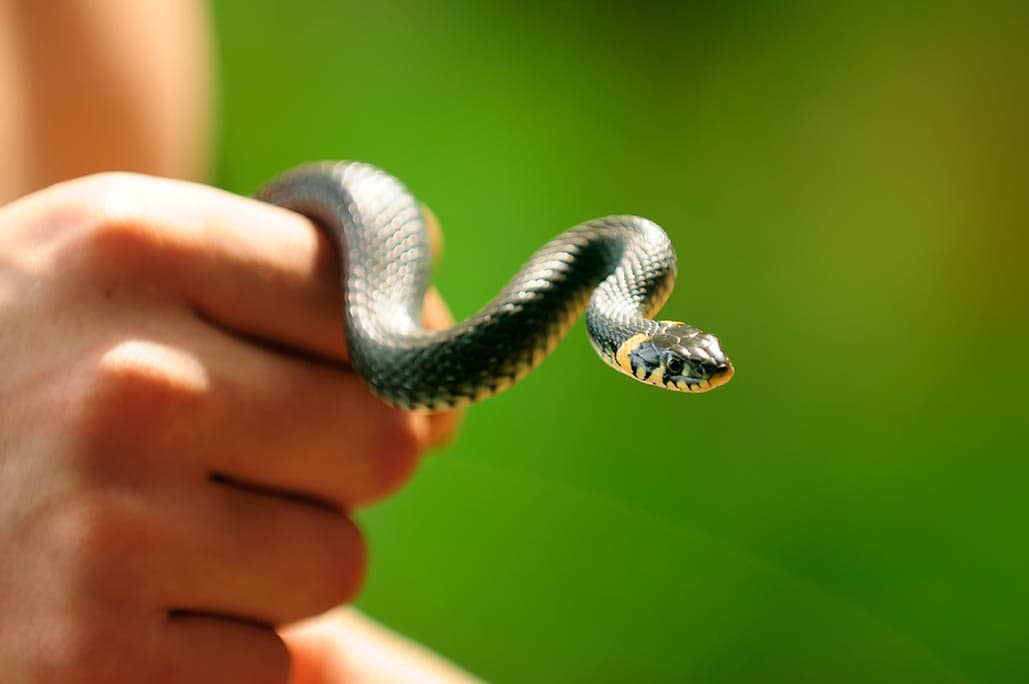
Arguably the most popular snake to own as a pet is the corn snake. Corn snakes are docile, affordable, and easy to take care of. Not to mention, they come in many morphs. One of the more popular morphs is the candy cane morph.
Candy cane corn snakes are really attractive, yet they are still easy to take care of and fun to handle. To learn more about this interesting reptile, read on. Hopefully, this article will help you decide if the candy cane corn snake is right for you.
Quick Facts About the Candy Cane Corn Snake

| Species Name: | Pantherophis guttatus |
| Common Name: | Corn snake |
| Care Level: | Beginner |
| Lifespan: | 10–12 years |
| Adult Size: | 4–5.5 feet |
| Diet: | Small rodents |
| Minimum Tank Size: | 20-gallon terrarium |
| Temperature & Humidity: | Temperature gradient low 70s to 85 degrees Fahrenheit; humidity: ~50% |
Do Candy Cane Corn Snake Make Good Pets?
Corn snakes are one of the best snakes to have as a pet. They are very docile, easy to take care of, and aren’t too big. These snakes are also much more receptive to being handled than other snakes, making them a favorite amongst those who want to hold their snake.
Corn snakes with the candy cane morph are less popular as pets simply because they are less available than regular corn snakes. So long as you are willing to spend a little extra time and money finding this morph, candy cane corn snakes make good pets.
Appearance
Corn snakes are between 4 and 5.5 feet in length. They come in various morphs, one of which being the candy cane morph. As this morph name suggests, candy cane corn snakes are red and white.
The exact pattern differs from snake to snake, but they all have a recessive gene that allows them to have a primarily white body with red patches.
How to Take Care of Candy Cane Corn Snakes
One reason why corn snakes are one of the more popular reptile pets is that they are pretty easy to take care of. They are native to temperate environments, meaning they don’t have as extensive of humidity or temperature requirements as other snakes.
Related Read: Red Corn Snake
Habitat, Tank Conditions & Setup
Corn snakes are a bit smaller than other pet snakes, and they live in more temperate environments. These two facts together mean that the snake is much easier to care for than other snakes, which is why it is a favorite among beginner reptile enthusiasts.
Tank
Because of the smaller size of these snakes, corn snakes only need a 20-gallon reptile terrarium. However, you can always go bigger if you have the room. Your snake will appreciate it. Do not house more than one snake inside a terrarium because snakes are not social, no matter how large the terrarium is.
Make sure that the tank you select has a lid that attaches pretty securely. Corn snakes are great escape artists. Inside the tank, place climbing branches and hides for the snake to explore and feel safe.
Spot clean the tank every day. Especially during shedding times, keep the tank free from any debris or dirty items. Deep clean the tank once a month with reptile-safe cleaner.

Lighting
Corn snakes do not need any type of additional lighting. Simply placing the cage somewhere where it has access to the natural day cycle will be enough. Don’t put the tank in direct sunlight, however, because that can make the temperature too hot.
Heating (Temperature & Humidity)
Even though corn snakes do not require extensive lighting, they do require heating and humidity. You will likely need an under-tank heat pad or cable to provide the correct gradient.
You want the warm end to be around 85 degrees Fahrenheit and the cool end to be around room temperature, or the low 70s. We recommend placing a hollow log between these two areas so that there is a hide in both.
Corn snakes do not need as high of humidity as most snakes. Room humidity is enough for most corn snakes. However, placing moist moss in the tank whenever the snake is shedding can help a lot.
Substrate
Breeders prefer cyprus or aspen shavings for substrate, but you can also use newspaper or paper towels. Shavings are the best for corn snakes because they are likely to crawl underneath the paper if given the opportunity. Do not use sand or any type of aromatic wood.
| Tank Recommendations | |
| Tank Type: | 20-gallon glass vivarium |
| Lighting: | N/A |
| Heating: | Heating pad/tape on bottom of enclosure |
| Best Substrate: | Aspen bedding |
Feeding Your Candy Cane Corn Snake
Corn snakes are pretty small animals, meaning their diet needs to come from other small sources. Small rodents are best. Frozen pinky mice are recommended because they are appropriately sized for the corn snake, yet they will not fight back.
Baby corn snake should be fed once every week, whereas adult corns snakes should be fed every 7–10 days.
| Diet Summary | |
| Meat | 100% of diet – small sized rodents |
| Supplements Required | N/A |
Keeping Your Candy Cane Corn Snake Healthy
Corn snakes are relatively healthy, but certain morphs are prone to neurologic disorders. Getting your candy cane corn snake from a reputable breeder helps to prevent these disorders from showing up in your snake.
Additionally, keeping their tank clean and providing them with a proper diet will keep most healthy. As a whole, snakes are really healthy if they’re given the right environment and food.
Common Health Issues
Lifespan
Corn snakes typically live between 10 and 12 years. This is not as long as most other snakes, but this is longer than they would live in the wild. Making sure to provide your corn snake the proper environment and diet can ensure it lives as long as possible.
Breeding
Another reason why corn snakes are such a popular breed for captivity is that they are much easier to breed than other snake varieties. Providing the correct conditions for breeding is largely all that is required for mating corn snakes.
You will want to begin mating by providing a cooler temperature to replicate winter. Then, gradually bring the temperatures up to replicate spring. At this point, the snakes will be ready to mate.
Place the male into the female’s enclosure. If things go right, they will mate. Remove the male after they have mated and pay attention to the female to see if the mating was successful. Provide a nesting box for the eggs and place them in an incubator once they are laid.
Are Candy Cane Corn Snakes Friendly? Our Handling Advice
New hatchlings can be defensive, meaning they may hide or try to defend themselves when you handle them. Luckily, corn snake hatchlings cannot hurt you. Even though the hatchling cannot hurt you, we recommend avoiding handling until it gets more accustomed to its new home.
Once the corn snake settles into its home, it will begin to get more adjusted to you and handling. Whenever you are ready to handle your snake, make sure to be confident and quick. Any hesitation may cause more stress for the snake. Begin in short bursts and gradually hold the snake for more as it gets more comfortable.
Shedding: What to Expect
As your corn snake ages, it will shed. Hatchlings and baby corn snakes shed more often simply because they are growing more. Whenever the corn snake is in its adult stage, it will likely only shed every couple of months.
You can determine that your snake is about to shed by looking at its appearance. Corn snakes often get darker, duller, and cloudy looking eyes. This is a sign that the snake is about to shed.
Whenever the corn snake is shedding, minimize handling as much as possible. Instead, add a little bit more humidity to the enclosure so that the skin slides off a bit easier. Make sure to clean up any dead skin after the shedding period is done.
How Much Do Candy Cane Corn Snakes Cost?
Corn snakes are some of the most readily available reptiles. As a result, they are very inexpensive. You can find candy cane corn snakes online for about $70. This is a bit more expensive than regular corn snakes, which are priced at around $30.
You can look at local exotic pet shops for a candy cane corn snake, but they may not have this morph. More likely, you will have to look online for this morph.
Care Guide Summary
Final Thoughts
Candy cane corn snakes are really attractive, yet they make good pets because they are easy to take care of and are easily found. The biggest thing to be careful about is the enclosure you put it in. The enclosure will determine its health and life span.
So long as you are careful about its enclosure, the candy cane corn snake makes a great and healthy pet for reptile lovers!
Related Read:
- Blizzard Corn Snake: Facts, Info & Care Guide (with Pictures)
- Corn Snake Feeding Chart: Schedule, Tips & Diet
Featured Image Credit: Nutthagreth Chaiwong, Shutterstock










